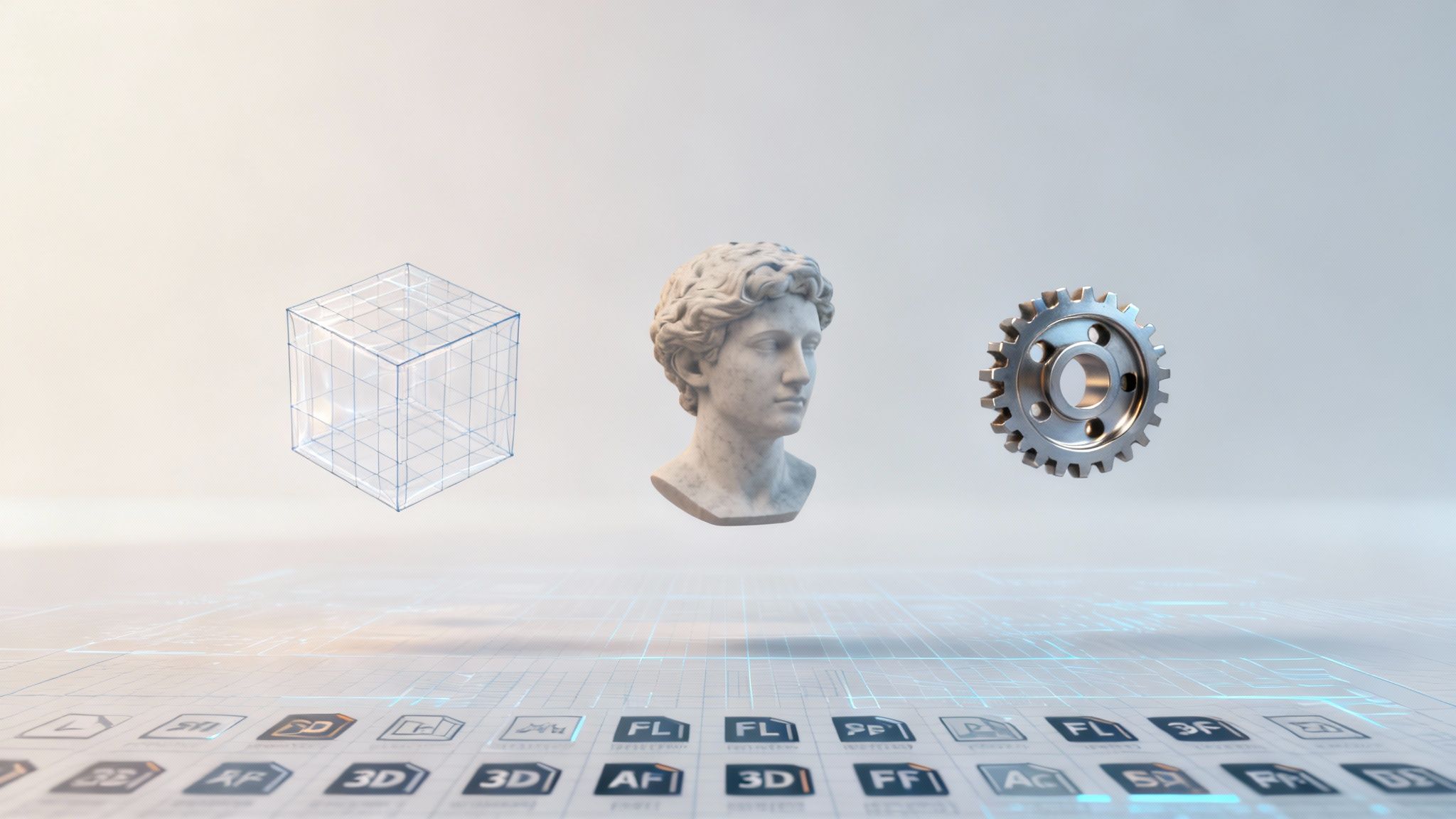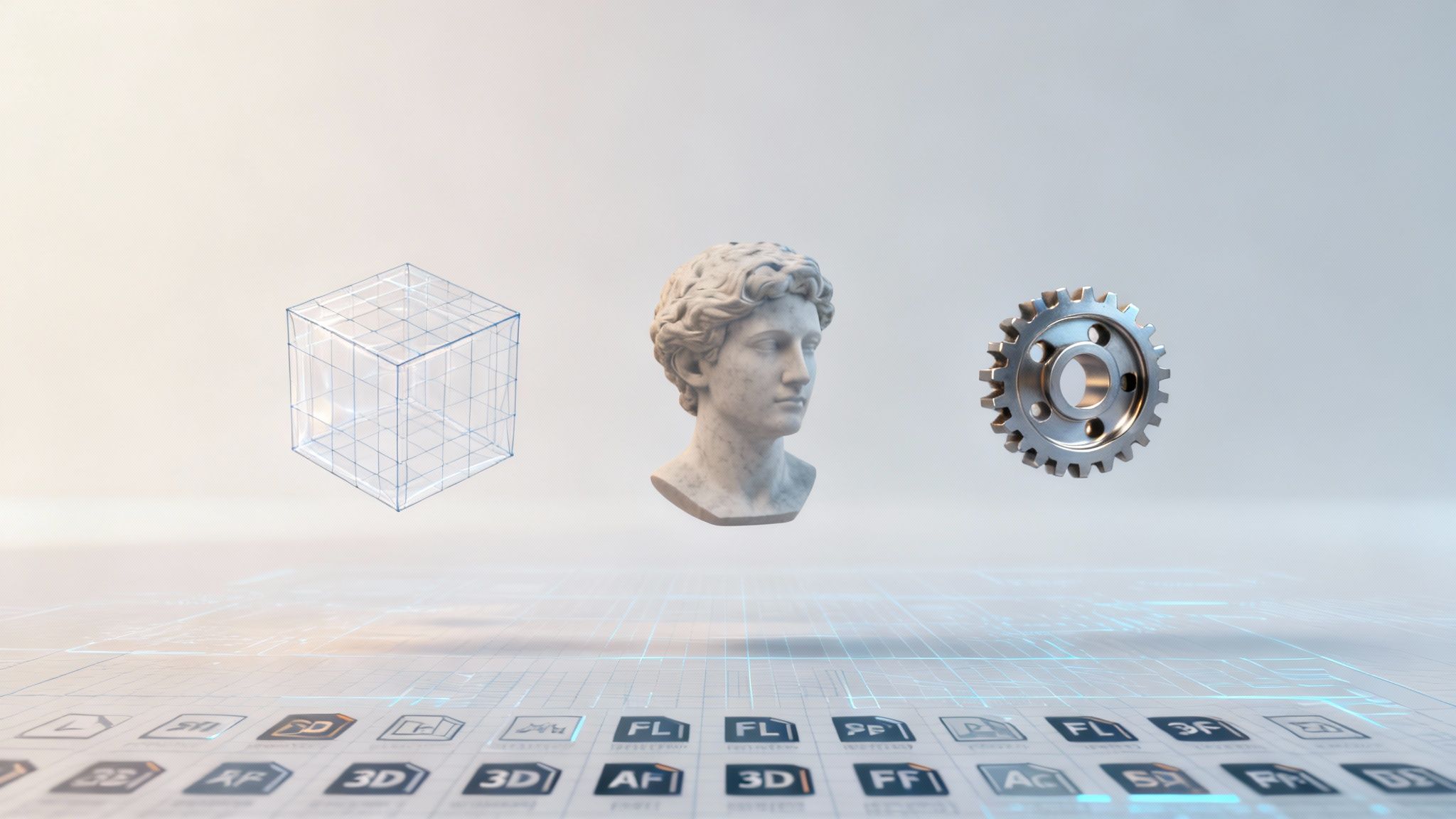Think of 3D model file formats as the digital blueprints for three-dimensional objects. They contain all the instructions defining everything from an object's basic shape and appearance to how it moves and interacts with light.
Selecting the right format—such as OBJ, FBX, or STL—is a critical decision that has a significant impact on downstream processes. A correct choice ensures your project moves smoothly between different software and platforms. An incorrect choice can lead to compatibility issues and workflow disruptions. The optimal choice is always determined by the end goal, whether that's 3D printing, game development, or a professional AR experience on the web.
Why 3D Model File Formats Matter
3D file formats can be compared to different languages, each designed for a specific purpose.
A format like STL uses a simple, direct language. It is ideal for describing the raw, geometric shell of an object to a 3D printer. It focuses solely on the shape. While efficient and direct, it cannot express details like color, texture, or animation.
Conversely, a format like FBX is a comprehensive storytelling tool. It can describe not only an object's shape but also its complex surface textures, skeletal animations, lighting setups, and camera data. This rich vocabulary makes it the standard language for enterprise-level game development and filmmaking, where these intricate details are essential.
This is precisely why numerous 3d model file formats exist. Each is a specialized tool, optimized to solve a specific business or creative problem.
The infographic below outlines some of the most common formats you will encounter in both creative and technical workflows.

As shown, every format fills a niche. You have the web-optimized glTF, the universally compatible OBJ, and a range of others. This underscores the need to match the file type to the requirements of the task.
The Impact on Your Creative Workflow
Choosing the appropriate format from the outset can prevent significant issues later in the project lifecycle. Using a format built for engineering precision when you require real-time web performance will result in slow load times and a poor user experience.
Conversely, using a visually-focused format for a manufacturing prototype could result in a failed print because it lacks the precise geometric data the machinery requires.
The core challenge is always balancing fidelity with performance. A high-fidelity model with 8K textures and complex animations is perfect for a cinematic render. However, for an interactive web application that must load in under two seconds, it is entirely unsuitable.
Achieving this balance is key to an efficient creative pipeline. Your choice of format directly affects several critical aspects of any project:
- Interoperability: How easily can you move a model between different programs? Consider the transition from a modeling tool like Blender to a game engine like Unity.
- Performance: The file size and data structure determine how quickly a model loads and renders. This is critical for web, AR, and VR applications.
- Data Richness: Does the format support the necessary data? Not all formats can handle textures, colors, animations, or skeletal rigs.
- Future-Proofing: Adhering to a widely supported, open-source format helps ensure your assets remain usable for years to come.
These formats are the foundation of modern digital creation. To better understand their role in the broader context, this overview of What is CGI Animation: A Complete Guide to Digital Creation provides valuable insights.
As we examine specific formats, you will see how these principles apply in real-world scenarios.
To help you get started, here is a quick reference guide summarizing the most popular formats we will cover.
Quick Guide to Common 3D File Formats
This table outlines the essential characteristics and primary uses for the formats you are most likely to encounter.
This is just a starting point. True expertise comes from knowing not just what each format is, but when and why to use it over another. Let's delve deeper.
Exploring Foundational Formats Like OBJ and FBX
When you begin working with 3D model file formats, you will quickly encounter two industry mainstays: OBJ and FBX. These can be considered foundational building blocks for countless projects. While both are used to transfer assets between different software, they solve different problems—much like the difference between a simple text file and a rich multimedia document.

Understanding their unique strengths is the first step toward a more efficient and predictable workflow. Choosing the right one for the job helps avoid compatibility issues and ensures your creative vision is translated accurately from one application to the next.
OBJ: The Universal Translator
The OBJ (or .obj) format is one of the oldest and most widely supported formats, originally developed by Wavefront Technologies. Its exceptional compatibility makes it the "plain text" of the 3D world. Nearly every 3D modeling and rendering application can open and save an OBJ file, making it a highly reliable choice for transferring static models.
An OBJ file excels at storing core geometric data—the vertices, faces, and normals that define an object's shape. It also supports UV coordinates, which are critical for applying textures. If you are new to this concept, our guide on what UV mapping is is an excellent resource.
However, the simplicity of OBJ is also its main limitation. It cannot handle complex scene data such as animations, skeletal rigs, lights, or cameras.
The greatest strength of the OBJ format is its universal simplicity. It is a dependable, open-standard format for sharing mesh geometry and basic material information across almost any 3D software pipeline without complications.
This makes OBJ the ideal tool for several specific tasks:
- Archiving static models for future use in software you may not currently own.
- Sending a model to a 3D printer when color data is required (unlike the simpler STL format).
- Transferring a character sculpt from a program like ZBrush to a texturing application before the rigging process begins.
Its reliability is its key feature. The model’s core structure remains intact, regardless of its destination.
FBX: The Multimedia Container
On the other end of the spectrum is FBX (.fbx), a powerful, proprietary format developed by Autodesk. It functions less like a simple file and more like a multimedia container. It is the go-to standard in professional pipelines for game development, film, and VFX because it can store much more than just geometry.
An FBX file can bundle an entire scene into a single package. This includes not just the 3D model and its textures, but also complex animations, skeletal rigs, lighting setups, and camera data. This all-in-one capability is why it is indispensable for moving an animated character from, say, Maya or Blender into a game engine like Unity or Unreal Engine.
The growth of the 3D modeling market has been fueled by formats like these. OBJ, originating in the 1990s, and FBX, enhanced by Autodesk in the 2000s, are dominant in entertainment and gaming because they handle everything from simple meshes to complex animated scenes. You can find more details on the 3D models market growth on businessresearchinsights.com.
Choosing Between OBJ and FBX
So, how do you decide which of these 3D model file formats to use? The decision often comes down to one simple question: does your model need to move?
If you only need to transfer the static shape and appearance of an object, OBJ is a simple, robust choice. However, if you are working with a fully rigged and animated character, FBX is the only viable option between the two.
To make the distinction even clearer, let's look at a direct comparison.
Feature Comparison Between OBJ and FBX
This table breaks down the core differences at a glance, helping you decide which format fits your immediate needs.
Ultimately, both formats are essential tools in any 3D artist's toolkit. The key is knowing when the straightforward reliability of OBJ is sufficient, and when you need the feature-rich power of FBX to bring a dynamic creation to life.
Specialized Formats for Manufacturing and CAD
While formats like FBX are designed for visual storytelling, a different class of 3d model file formats governs the world of engineering and physical production. In this domain, precision is not just a desirable quality; it is the primary objective. These formats function less as creative assets and more as precise digital blueprints, ensuring a design transitions flawlessly from a screen to a real-world object.
The priorities here shift entirely. Animations, advanced PBR materials, and complex scene hierarchies are irrelevant. The focus is on mathematical accuracy, data integrity, and a universal language between computer-aided design (CAD) and computer-aided manufacturing (CAM) systems.
STL: The Bedrock of 3D Printing
If you have ever used a 3D printer, you are familiar with the STL (Stereolithography) format. It is the undisputed workhorse of the additive manufacturing industry for one simple reason: its incredible straightforwardness.
An STL file can be thought of as the hollow shell of an object, described by a vast network of interconnected triangles—a tessellated mesh. This structure is brilliantly simple and is precisely what 3D printer "slicer" software is designed to interpret. A slicer's function is to divide a model into hundreds or thousands of flat layers, and a surface made of simple triangles is the easiest possible shape to process.
However, this simplicity comes with significant trade-offs:
- Geometry Only: An STL contains no information about color, texture, or materials. It is pure, unadorned shape.
- No Scale Information: The format lacks built-in units. A model could be interpreted as millimeters or inches depending on the software that opens it.
- Potential for Errors: Its minimalist structure can sometimes lead to issues like holes or non-manifold edges, which can cause a print to fail if not corrected beforehand.
Despite these limitations, STL remains essential due to its widespread adoption. For a more detailed look, our guide on 3D printing file formats provides comprehensive information.
STEP and IGES: The Digital Blueprints of Engineering
When absolute, non-negotiable precision is required, engineers and product designers rely on robust CAD formats like STEP (Standard for the Exchange of Product model data) and IGES (Initial Graphics Exchange Specification). Unlike mesh formats that approximate surfaces with polygons, these are true digital blueprints.
They use complex mathematics—often NURBS (Non-Uniform Rational B-Splines)—to define surfaces with perfect geometric accuracy. This means a curve is a true mathematical curve, not an approximation made of tiny straight lines. In manufacturing, that distinction is crucial.
Imagine designing a high-performance engine piston. A shape that is "almost right" is completely unacceptable; the part must fit with micron-level accuracy. STEP and IGES files preserve this exact mathematical data, guaranteeing that a part designed in one CAD system can be flawlessly manufactured by another.
This level of precision is why these formats are vital in professional workflows and highlights how different industries require their own specialized 3d model file formats. If you are curious about how these digital files become physical objects, exploring different rapid prototyping methods is a great way to understand that process.
The rise of these specialized formats reflects the expansion of 3D technology into critical industries. STEP, first standardized in the 1980s, became a global standard, handling more than 60% of all CAD data exchanges by the late 2010s. Simultaneously, the explosion in 3D printing has solidified STL’s position as the top format, representing over 80% of 3D print data worldwide. This serves as a powerful reminder to always choose the format that speaks the right technical language for the job.
The Future of Web 3D with glTF and USD
While traditional formats have their established roles, the most significant innovation is occurring with two modern powerhouses: glTF and USD. These were not just incremental updates; they were developed from the ground up to solve the performance and collaboration challenges inherent in web-based 3D, augmented reality, and large-scale visual effects productions.
They represent a fundamental shift in how we approach 3D files—moving from heavy, monolithic containers toward lightweight, streamable, and collaborative formats.

Unlike older formats, glTF and USD are designed for a world where 3D content must load instantly over the internet or be managed by large, distributed creative teams. Understanding their distinct advantages is key to building next-generation applications.
glTF: The "JPEG of 3D"
glTF (GL Transmission Format) is often called the "JPEG of 3D," and for good reason. It is an open-standard format engineered for one purpose: to be incredibly compact and exceptionally fast to load. This has made it the undisputed standard for web and AR experiences.
Before glTF, displaying a 3D model in a browser was a cumbersome process. The browser had to download a large, complex file and then expend significant time and processing power to convert it into something the graphics card could render.
glTF completely bypasses this issue. It delivers an asset that is already in a format the GPU can understand directly. This significantly reduces the workload on the device, resulting in dramatically faster load times and smooth performance—which is absolutely critical for e-commerce product viewers, online configurators, and mobile AR applications.
Consider this analogy: an FBX file is like raw camera footage that requires editing and processing. A glTF file is the final, compressed video, ready for streaming. It is optimized for delivery, not for editing.
Since its introduction in 2015 by the Khronos Group, glTF has been a transformative force for web 3D. Its adoption is growing by roughly 20% annually in web AR systems alone, a testament to its effectiveness in solving a real-world problem. You can explore the impact of these modern 3d model file formats in this 3D models market report.
USD: The Blueprint for Complex Scenes
If glTF is the master of delivering final assets, then USD (Universal Scene Description) is the master of creating them. Developed and open-sourced by Pixar Animation Studios, USD is more than just a file format; it is a powerful framework for managing and collaborating on extraordinarily complex 3D scenes. It is best thought of not as a file, but as a powerful "scene blueprint."
The key innovation of USD is its non-destructive layering system. Imagine a large team of artists working on a single digital set for a film. One artist can adjust the lighting, another can refine character models, and a third can build out the landscape—all simultaneously, on the same scene.
Each artist's work is saved as a separate layer. USD then composites these layers together in real-time to create the final, complete scene. This allows an individual to make a significant change to their layer without overwriting or disrupting anyone else's work. For large-scale VFX and virtual production, this capability is revolutionary.
What makes USD so powerful?
- Non-Destructive Workflows: Edits are stored in layers, preserving the original data. This gives teams incredible flexibility to experiment and iterate.
- Collaboration at Scale: It is designed to allow hundreds of artists to contribute to the same scene simultaneously without conflicts.
- Exceptional Performance: USD is highly optimized for loading and interacting with massive datasets, including scenes with billions of polygons.
These two formats are not competitors. They are two sides of the same coin, solving different problems. USD is for building complex worlds, and glTF is for delivering those worlds to the end-user—efficiently and beautifully.
How to Choose the Right 3D Model Format
You now have an understanding of the major 3D model file formats. The next step is to apply this knowledge. Selecting the right format is not about finding a single "best" file type; it is a strategic choice that depends entirely on your model's destination and function.
Making the right choice will save you from rework, compatibility issues, and workflow disruptions. The key is to ask a few critical questions before you export your file.
Start with the Final Destination
This is the single most important question to answer. Where will this 3D model be used? The requirements of a game engine are entirely different from those of a 3D printer or a web browser.
Consider these common destinations:
- Game Engines (Unity, Unreal): Performance and data integrity are paramount. FBX is the undisputed industry standard. It flawlessly transports animations, rigs, materials, and all the complex data that game engines rely on.
- Web Browsers and AR/VR: Speed is the top priority. glTF (and its binary version, GLB) was specifically designed for this purpose. It is built for lightning-fast loading and efficient rendering directly on the GPU.
- 3D Printing: The printer’s slicer software requires clean, simple geometry. STL is the universal language for this task, though 3MF is a more modern alternative that can also carry color and material information.
- CAD and Manufacturing: Precision is non-negotiable. You will need STEP or IGES to preserve the exact mathematical data that engineering workflows demand.
Answering this question first will immediately narrow your options from a dozen to just two or three suitable choices.
Evaluate Your Data Requirements
Next, take an inventory of what information your file needs to contain. Not all 3D model file formats are created equal—a mismatch here can result in critical data being lost in translation.
Does your model include:
- Animation: If you have a skeletal rig, keyframes, or blend shapes, your choice is clear. FBX was built for this, as was glTF for web-based animation. Exporting this in an OBJ or STL will strip away all motion data.
- Complex Materials and Textures: If you need to preserve PBR materials with metallic and roughness maps, glTF and FBX are your best options. An OBJ can handle basic textures, but its material system is far more primitive.
- Color Data: For simple vertex colors or multi-material 3D prints, formats like 3MF or OBJ are sufficient. An STL, on the other hand, contains no color information; it is pure geometry.
Think of it like packing for a trip. For a simple outing (a static model), a small bag (OBJ) is enough. But for a major move (a fully animated character), you need a large container that can hold everything (FBX).
Common Mistakes to Avoid
Knowing what to do is half the battle; knowing what not to do is the other half. Most workflow issues arise from a few common, avoidable mistakes. Remember that the software you use for modeling will also influence your options; review this 3D modeling software comparison to see how different tools handle various formats.
- Using a heavy format for a simple task: Exporting a static, untextured prop as an FBX is unnecessary. A lightweight OBJ would be smaller and more widely compatible.
- Relying on STL for visual projects: Do not use an STL if your model requires textures or color for a portfolio render. All visual work will be discarded.
- Ignoring the pipeline: This is a major pitfall. Always confirm which formats your collaborators or the next software in your workflow can accept. Assuming compatibility is a recipe for problems.
By considering your destination, data, and these potential traps, you can select the perfect 3D model file format with confidence every time.
What's Next for 3D File Formats?
The world of 3d model file formats is continuously evolving. New technologies are constantly pushing the boundaries of what a 3D asset can be, making traditional approaches seem outdated. The future is not about static shapes; it's about dynamic, intelligent, and interconnected 3D content.
This shift demands new standards—formats built for a more complex and collaborative digital world.
One of the most significant game-changers is the rise of procedural generation and AI in content creation. Traditional file formats excel at storing the final shape of a model. But what if a format could store the logic behind it instead? This involves the rules, parameters, and algorithms used to generate the object.
This approach opens the door to infinite variations and non-destructive editing, which is essential for large-scale game development and building virtual worlds.
The Big Move to the Cloud
Another major trend is the industry-wide shift to cloud-based workflows. With creative teams more geographically dispersed than ever, there is a need for formats designed for the cloud. This means they must support efficient streaming, robust version control, and seamless collaboration.
A format that allows multiple artists to modify a file simultaneously without creating conflicting versions is no longer a luxury—it is a necessity.
This is all tied to the explosive growth of AR, VR, and the metaverse. These platforms push real-time rendering to its absolute limits, demanding formats that are both incredibly lightweight for fast delivery and rich enough to support truly immersive, interactive experiences.
The next generation of 3D file formats will not just store an object's appearance. They will store its entire history—the procedural recipe and the collaborative journey behind its creation. This is how assets become flexible, scalable, and ready for enterprise-level applications.
This evolution is a direct response to developments in fields like AI-driven design and augmented reality. The global 3D digital asset market reached an estimated USD 28.3 billion in 2024 and is projected to exceed USD 51.8 billion by 2029. This growth highlights the critical importance of advanced 3d model file formats.
If you wish to explore the data further, you can discover more about the 3D asset market's future on grandviewresearch.com.
For any modern creative team, staying ahead of these trends is non-negotiable. By adopting formats designed for proceduralism, cloud collaboration, and real-time performance, you are not just future-proofing your pipeline; you are preparing it for the next wave of digital creation.
Burning Questions Answered
Navigating the world of 3D model file formats can be complex. Let's address some of the most common questions that arise during projects.
What’s the Go-To Format for 3D Printing?
For nearly any 3D printing application, STL is the undisputed standard. It is simple, reliable, and based on a triangular mesh structure that slicer software understands perfectly. It is a proven and effective solution.
However, if your project requires color, STL is not suitable. For models involving multiple colors or materials, formats like 3MF or OBJ are necessary, as they can store the additional color and material data that a basic STL file cannot handle.
Can You Actually Convert Between 3D File Formats?
Yes, conversion is possible. Most 3D modeling packages include built-in tools to import one format and export it as another. This is a common task in many workflows.
However, be aware that data loss can occur during translation. For example, converting a feature-rich FBX file—containing animations, complex materials, and lighting—into a minimalist STL file will strip away all that rich data, leaving only the raw geometry. Always verify your converted files to ensure no critical information has been lost.
A good rule of thumb is that you can always go from complex to simple, but you cannot go the other way. You cannot add animation data to an STL simply by converting it to FBX; that information must exist in the source file.
Which Format Rules for Web and AR?
The answer is clear: glTF is the leading format for web and augmented reality. It is often called the "JPEG of 3D" for good reason. It is highly optimized for small file sizes and extremely fast loading times, which are non-negotiable for smooth experiences on websites and mobile devices.
Its binary variant, GLB, offers further convenience. It bundles the entire 3D model, its textures, and all other data into a single, self-contained file. For delivering seamless 3D on the web, GLB is the optimal choice.
CAD vs. Mesh Formats: What’s the Real Difference?
This is a fundamental distinction. In short: CAD is for precision engineering, while mesh is for creative expression.
CAD formats like STEP and IGES use precise mathematics (NURBS curves) to define surfaces with measurable accuracy. This is essential for manufacturing and engineering, where every millimeter is critical.
Mesh formats like OBJ, FBX, and STL use a different method. They construct a shape from a network of points (vertices) connected by lines to form polygons. It is an approximation, but it is an incredibly efficient one that is ideal for animation, video games, and visual effects, where artistic freedom and real-time performance are more important than mathematical perfection.
Ready to bring your entire creative workflow under one roof? Virtuall is the AI-powered Creative OS that unifies 3D model, image, and video generation into a single, collaborative space. Go from idea to final asset faster than you ever thought possible. Learn more at Virtuall.pro.











